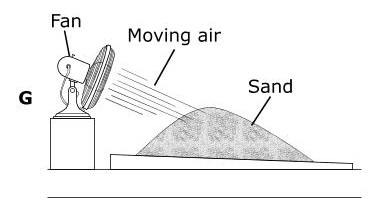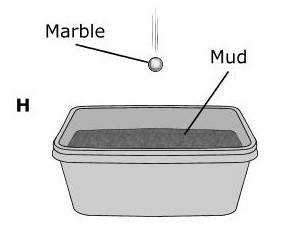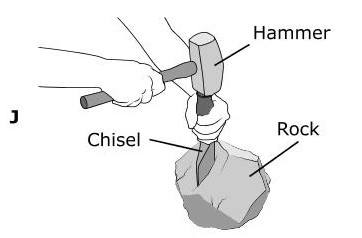
(R) 3.7B/5.7B Science STAAR (Rapid/Slow Changes--Landforms)
Quiz
•
Other Sciences
•
5th Grade
•
Medium
Bethany Hardy
Used 378+ times
FREE Resource
Enhance your content in a minute
12 questions
Show all answers
1.
MULTIPLE CHOICE QUESTION
5 mins • 1 pt
Glaciers are masses of ice that move slowly on land. Which of these features was most likely formed by a glacier? (5.7B)
A wide valley
A deep ocean
A lava flow
A mountain range
2.
MULTIPLE CHOICE QUESTION
5 mins • 1 pt

The Rio Grande Valley is located at the southern tip of Texas at the end of a long river known as the Rio Grande. How did the delta at the end of the Rio Grande form? (5.7B)
Sand and mud from the Gulf of Mexico were washed ashore by tsunamis.
The river cut through the solid bedrock of the valley.
The river deposited large amounts of sediment from land erosion.
Hurricanes pushed soil and debris from the Gulf of Mexico onto the land.
3.
MULTIPLE CHOICE QUESTION
5 mins • 1 pt
A student hiking in a rocky area on a mountain notices that wide, deep cracks have formed in some of the large rocks. Some of the cracks are so large that the rocks have broken apart. Which process most likely caused these rocks to crack and break? (5.7B)
Erosion by wind
Water freezing and thawing
Erosion by fast-moving water
Sediments being deposited
4.
MULTIPLE CHOICE QUESTION
5 mins • 1 pt

The photograph shows a canyon in northern Arizona. Which of these describes how this canyon was most likely formed? (5.7B)
Floods eroded the sandstone away from the canyon walls.
Glaciers eroded the canyon rock as they melted and moved.
Ice wedged into cracks in the rock and weathered the canyon walls.
Wind blew large rocks that smashed against the canyon walls.
5.
MULTIPLE CHOICE QUESTION
5 mins • 1 pt

A wide U-shaped valley is shown in the photograph. This valley was most likely formed by-- (5.7B)
flash flooding
a glacier
a hurricane
melting snow
6.
MULTIPLE CHOICE QUESTION
5 mins • 1 pt

Students constructed this model of a hill covering sugar cubes with clay. The students placed the model in a large pan and poured hot water over it every day for a week. What does this model best represent? (5.7B)
A method for removing fossil fuels from hills
The formation caves in hills
The formation of plains
A method for separating minerals
7.
MULTIPLE CHOICE QUESTION
5 mins • 1 pt

Monahans Sandhills State Park in Texas has almost 4,000 acres of sand dunes. Some of the dunes are as tall as a six-story building. The dune in the park are formed by-- (5.7B)
rainstorms
tornadoes
earthquakes
strong winds
Create a free account and access millions of resources
Create resources
Host any resource
Get auto-graded reports

Continue with Google

Continue with Email

Continue with Classlink

Continue with Clever
or continue with

Microsoft
%20(1).png)
Apple
Others
By signing up, you agree to our Terms of Service & Privacy Policy
Already have an account?
Similar Resources on Wayground

15 questions
Space Station
Quiz
•
1st - 8th Grade

10 questions
Using the Scientific Method
Quiz
•
5th - 6th Grade

12 questions
Research Questions and Doing Reseach
Quiz
•
5th - 10th Grade

15 questions
Ecosystems Vocabulary
Quiz
•
5th Grade

15 questions
Patterns in the Sky
Quiz
•
4th - 5th Grade

13 questions
Bowled Over
Quiz
•
4th - 8th Grade

16 questions
Science Quiz #1
Quiz
•
5th - 6th Grade

10 questions
Matter Changes
Quiz
•
4th - 6th Grade
Popular Resources on Wayground

10 questions
Honoring the Significance of Veterans Day
Interactive video
•
6th - 10th Grade

10 questions
Exploring Veterans Day: Facts and Celebrations for Kids
Interactive video
•
6th - 10th Grade

19 questions
Veterans Day
Quiz
•
5th Grade

25 questions
Multiplication Facts
Quiz
•
5th Grade

15 questions
Circuits, Light Energy, and Forces
Quiz
•
5th Grade

6 questions
FOREST Self-Discipline
Lesson
•
1st - 5th Grade

7 questions
Veteran's Day
Interactive video
•
3rd Grade

20 questions
Weekly Prefix check #2
Quiz
•
4th - 7th Grade
Discover more resources for Other Sciences

10 questions
What's Matter?
Quiz
•
4th - 8th Grade

15 questions
Part(icles) of Your World
Quiz
•
4th - 8th Grade

15 questions
Light Energy
Quiz
•
5th Grade

19 questions
Water Cycle
Quiz
•
5th Grade

10 questions
Hunting for Properties
Quiz
•
4th - 8th Grade

18 questions
Energy Conversions
Quiz
•
4th - 5th Grade

15 questions
Water Cycle
Quiz
•
5th - 6th Grade

13 questions
Weathering and Erosion
Quiz
•
4th - 8th Grade






